The Application of a Joint Distribution of Significant Wave Heights and Peak Wave Periods in the Northwestern South China Sea
Abstract
1. Introduction
2. Observational Data and Wave Model Configuration
2.1. Observational Data
2.2. Wave Model Configuration
2.3. Wave Model Validation
3. Method
3.1. Univariate Distribution Methods
3.2. Dependence Functions
3.3. Bivariate Distribution Methods
4. Results
4.1. Marginal Distributions of
4.2. Dependence Functions and Conditional Distributions of
4.3. Environmental Contours and Extreme Sea States
5. Conclusions
Author Contributions
Funding
Institutional Review Board Statement
Data Availability Statement
Conflicts of Interest
References
- Lee, U.J.; Cho, H.Y.; Lee, B.W.; Ko, D.H. Joint probability distribution of significant wave height and peak wave period using gaussian copula method. J. Coast. Res. 2023, 116, 96–100. [Google Scholar] [CrossRef]
- Bitner-Gregersen, E.M. Joint probabilistic description for combined seas. In Proceedings of the International Conference on Offshore Mechanics and Arctic Engineering 2005 (OMAE2005), Volume 2: Safety and Reliability, Ocean Space Utilization, Ocean Engineering, Halkidiki, Greece, 12–17 June 2005. [Google Scholar]
- Longuet-Higgins, M.S. On the joint distribution of the periods and amplitudes of sea waves. J. Geophys. Res. 1975, 80, 2688–2694. [Google Scholar] [CrossRef]
- Longuet-Higgins, M.S. On the Joint Distribution of Wave Periods and Amplitudes in a Random Wave Field. Proc. R. Soc. Lond. A 1983, 389, 241–258. [Google Scholar] [CrossRef]
- Sun, F. On the Joint Distribution of the Periods and Heights of Sea Waves. Acta Oceanol. Sin. 1987, 4, 503–509. Available online: http://www.en.cnki.com.cn/Article_en/CJFDTOTAL-SEAE198704001.htm (accessed on 10 March 2025).
- Zheng, G.; Jiang, X.; Han, S. The Difference between the Joint Probability Distributions of Apparent Wave Heights and Periods and Individual Wave Heights and Periods. Acta Oceanol. Sin. 2004, 23, 399–406. [Google Scholar]
- Stansell, P.; Wolfram, J.; Linfoot, B. Improved Joint Probability Distribution for Ocean Wave Heights and Periods. J. Fluid Mech. 2004, 503, 273–297. [Google Scholar] [CrossRef]
- Zhang, H.D.; Guedes Soares, C. Engineering Modified Joint Distribution of Wave Heights and Periods. China Ocean Eng. 2016, 30, 359–374. [Google Scholar] [CrossRef]
- James, J.P.; Panchang, V. Assessment of Joint Distributions of Wave Heights and Periods. Ocean Eng. 2024, 313, 119501. [Google Scholar] [CrossRef]
- Prince-Wright, R. Maximum Likelihood Models of Joint Environmental Data for TLP Design. In Proceedings of the International Conference on Offshore Mechanics and Arctic Engineering, Copenhagen, Denmark, 18–22 June 1995. [Google Scholar]
- Bitner-Gregersen, E.M.; Haver, S. Joint environmental model for reliability calculations. In Proceedings of the First International Offshore and Polar Engineering Conference, Edinburgh, UK, 11–16 August 1991. [Google Scholar]
- Bitner-Gregersen, E.; Soares, C.G.; Machado, U.; Cavaco, P. Comparison of different approaches to joint environmental modelling. In Proceedings of the 17th International Conference on Offshore Mechanics and Arctic Engineering (OMAE 1998), Lisbon, Portugal, 5–9 July 1998. [Google Scholar]
- Salvadori, G.; Durante, F.; Tomasicchio, G.R.; D’Alessandro, F. Practical Guidelines for the Multivariate Assessment of the Structural Risk in Coastal and Off-Shore Engineering. Coast. Eng. 2015, 95, 77–83. [Google Scholar] [CrossRef]
- Allard, R.; Rogers, E.; Carroll, S.N. User’s Manual for the Simulating Waves Nearshore Model (SWAN); Storming Media: New York, NY, USA, 2002. [Google Scholar] [CrossRef]
- Winterstein, S.R.; Ude, T.C.; Cornell, C.A.; Bjerager, P.; Haver, S. Environmental Parameters for Extreme Response: Inverse FORM with Omission Factors. In Proceedings of the ICOSSAR-93, Innsbruck, Austria, 9–13 August 1993. [Google Scholar]
- Wu, Y.; Randell, D.; Christou, M.; Ewans, K.; Jonathan, P. On the Distribution of Wave Height in Shallow Water. Coast. Eng. 2016, 111, 39–49. [Google Scholar] [CrossRef]
- Lucas, C.; Guedes Soares, C. Bivariate Distributions of Significant Wave Height and Mean Wave Period of Combined Sea States. Ocean Eng. 2015, 106, 341–353. [Google Scholar] [CrossRef]
- Zhao, M.; Deng, X.; Wang, J. Description of the Joint Probability of Significant Wave Height and Mean Wave Period. JMSE 2022, 10, 1971. [Google Scholar] [CrossRef]
- Bitner-Gregersen, E.M. Joint Met-Ocean Description for Design and Operations of Marine Structures. Appl. Ocean Res. 2015, 51, 279–292. [Google Scholar] [CrossRef]
- Huang, W.; Dong, S. Joint Distribution of Significant Wave Height and Zero-up-Crossing Wave Period Using Mixture Copula Method. Ocean Eng. 2021, 219, 108305. [Google Scholar] [CrossRef]
- Mathisen, J.; Bitner-Gregersen, E. Joint Distributions for Significant Wave Height and Wave Zero-up-Crossing Period. Appl. Ocean Res. 1990, 12, 93–103. [Google Scholar] [CrossRef]
- Haselsteiner, A.F.; Sander, A.; Ohlendorf, J.H.; Thoben, K.D. Global Hierarchical Models for Wind and Wave Contours: Physical Interpretations of the Dependence Functions. In Proceedings of the 39th International Conference on Ocean, Offshore and Arctic Engineering (OMAE 2020), Online, 3–7 August 2020. [Google Scholar]
- Chai, W.; Leira, B.J. Environmental Contours Based on Inverse SORM. Mar. Struct. 2018, 60, 34–51. [Google Scholar] [CrossRef]
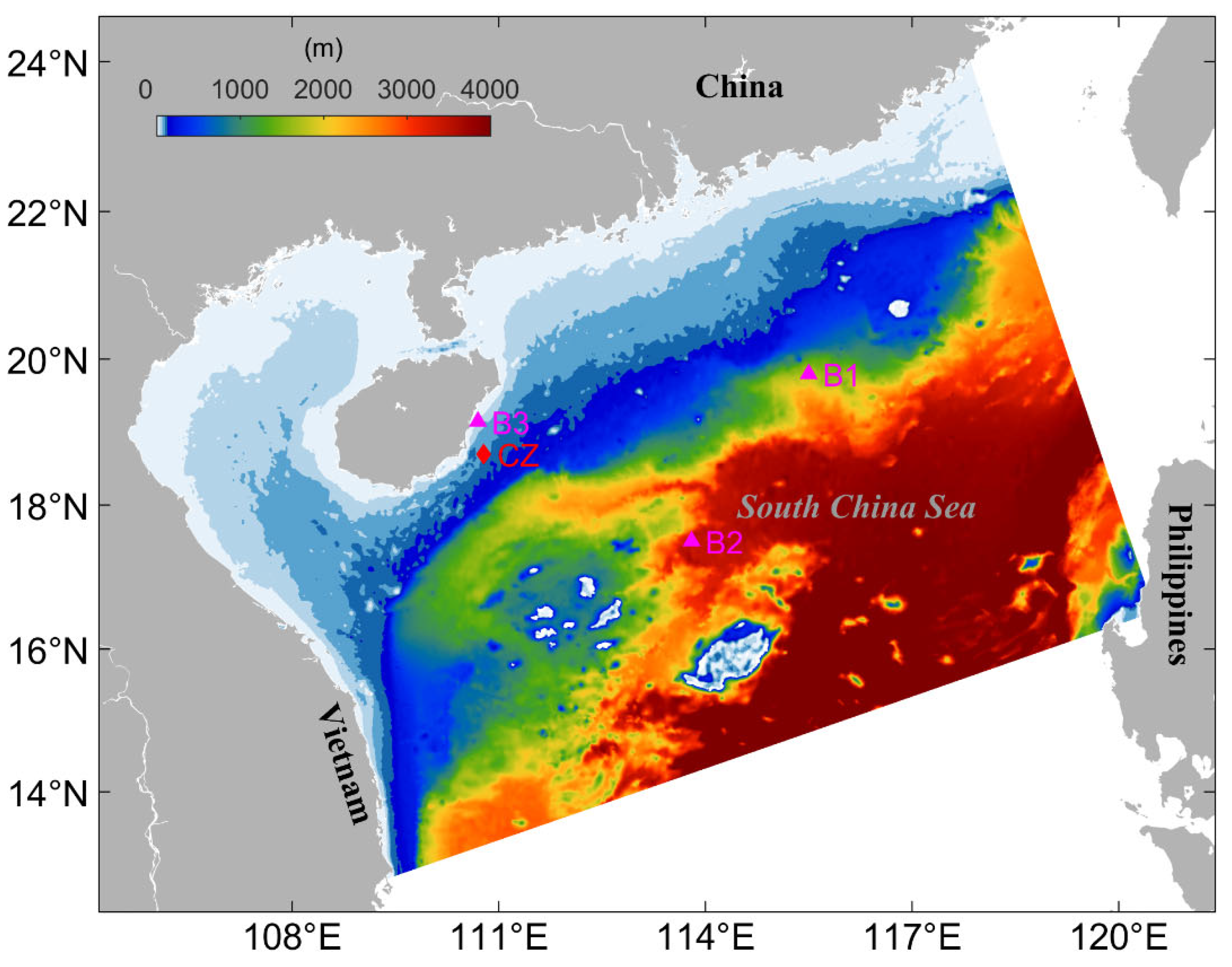

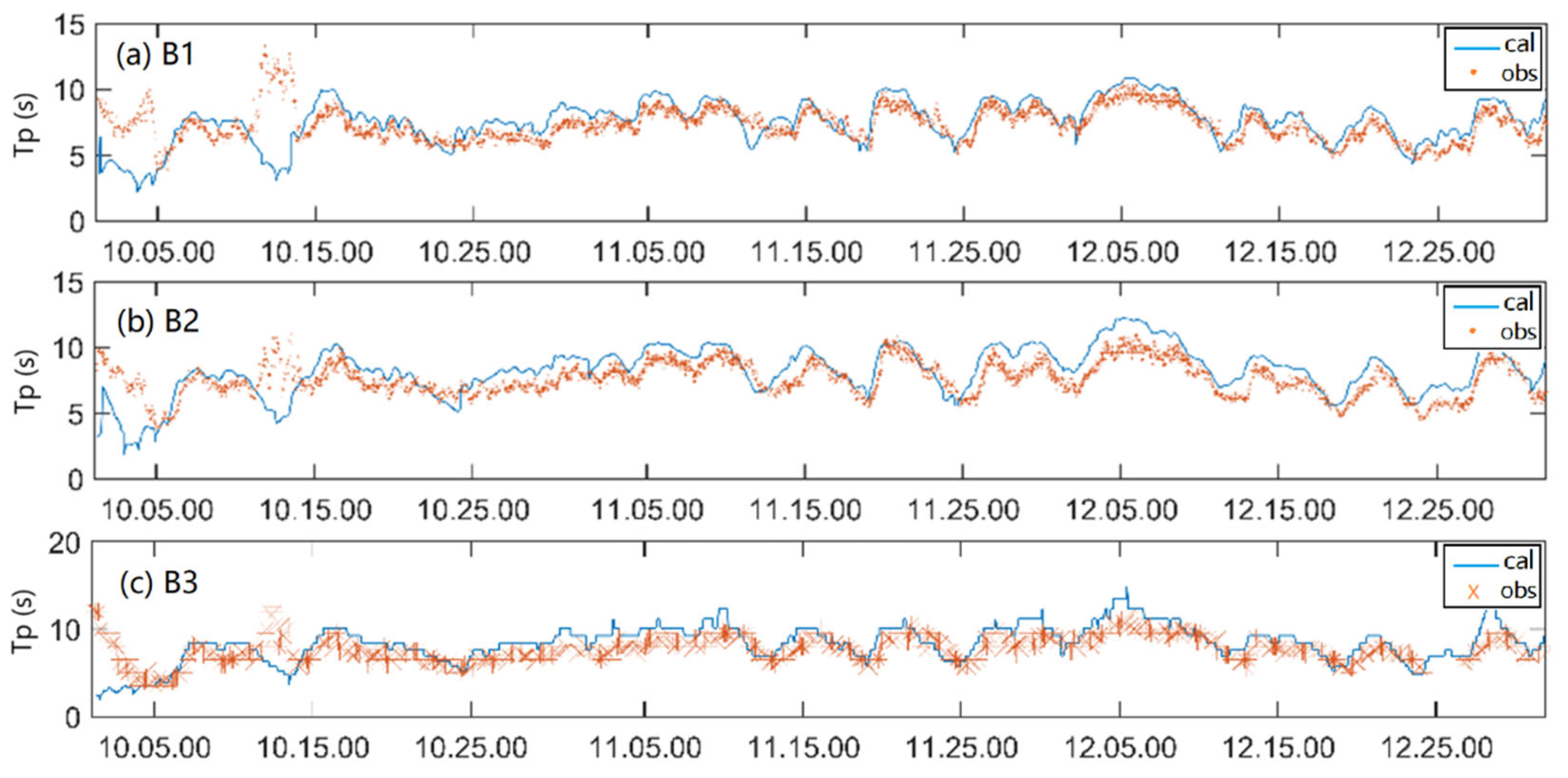
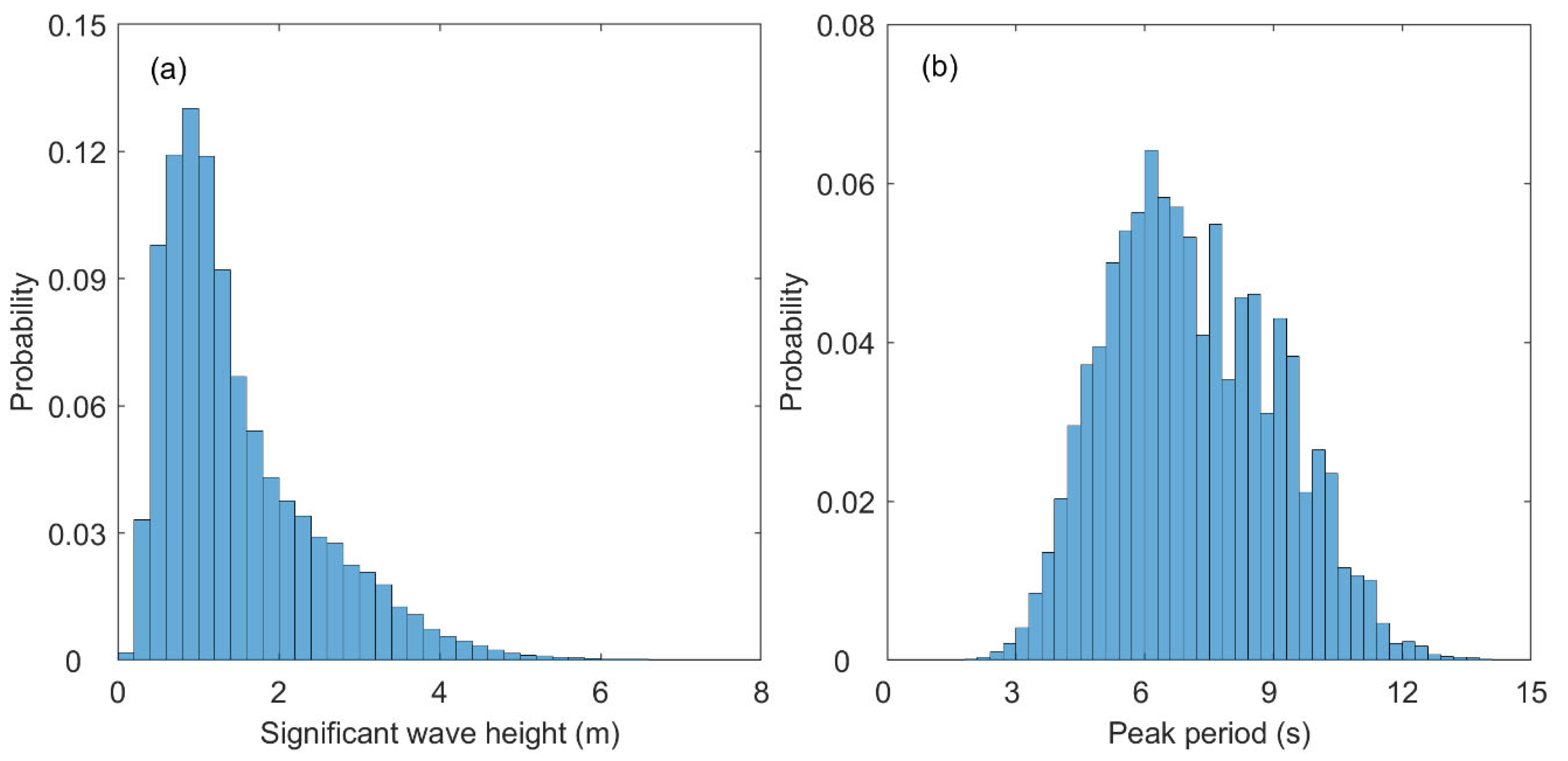

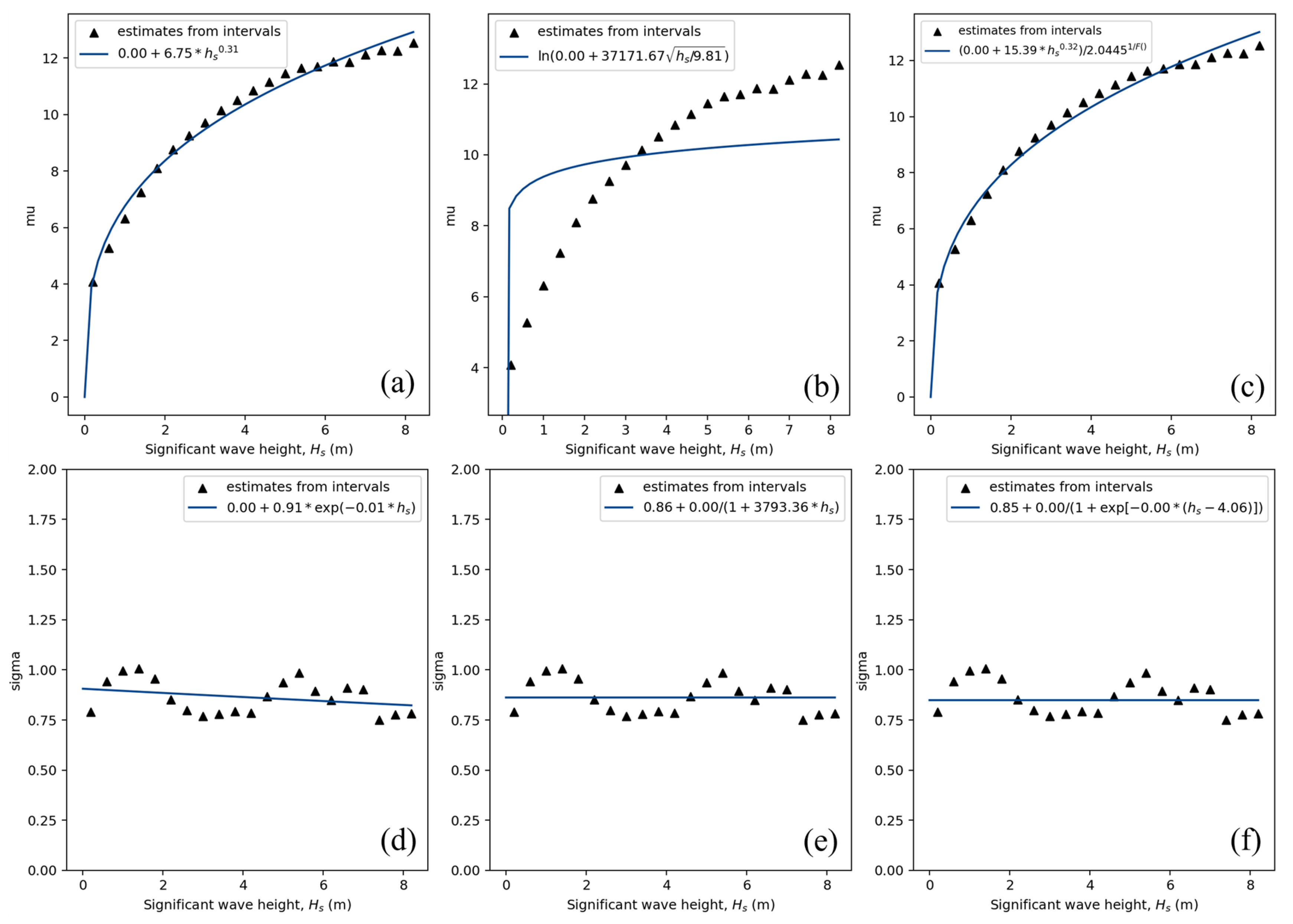

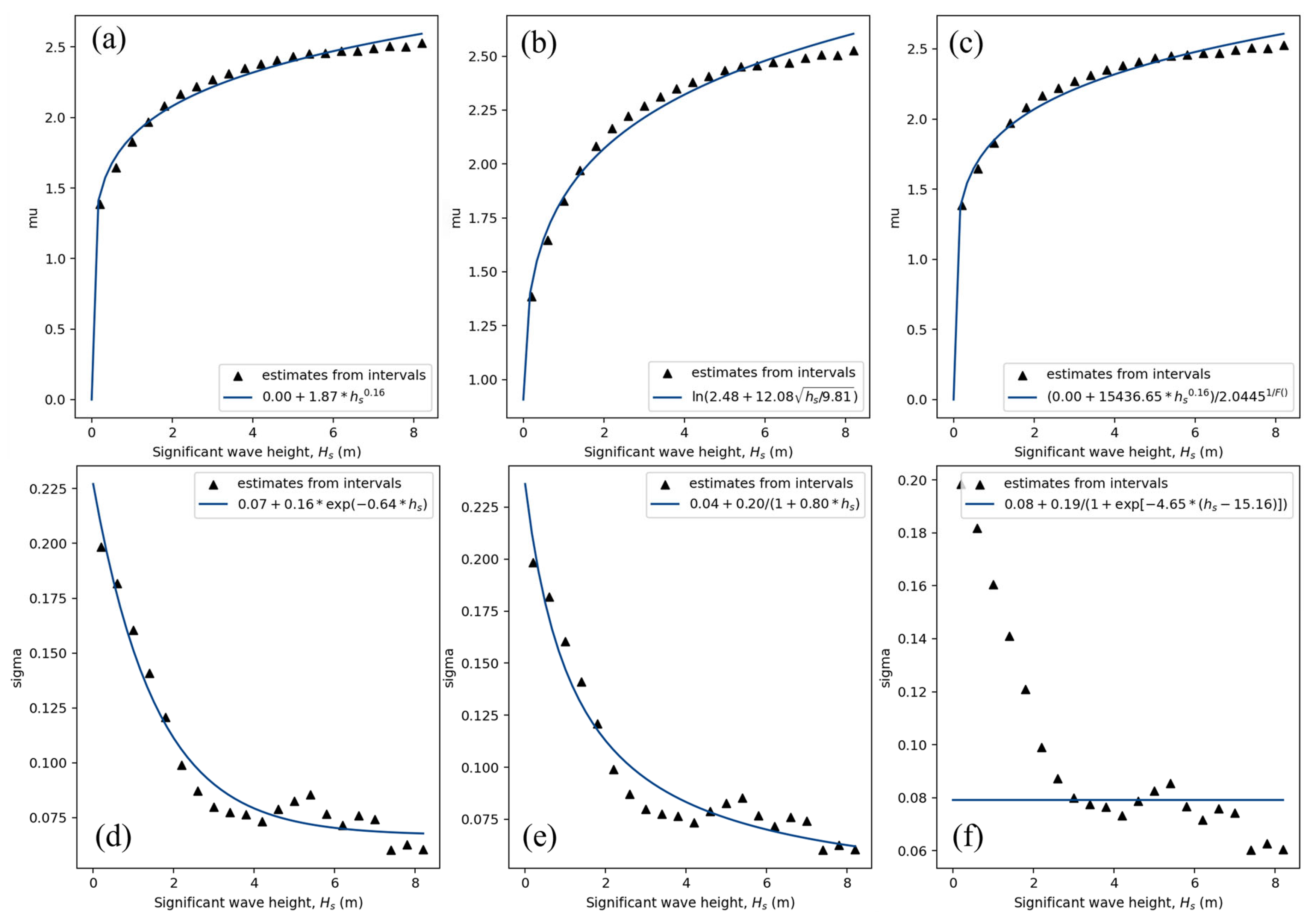
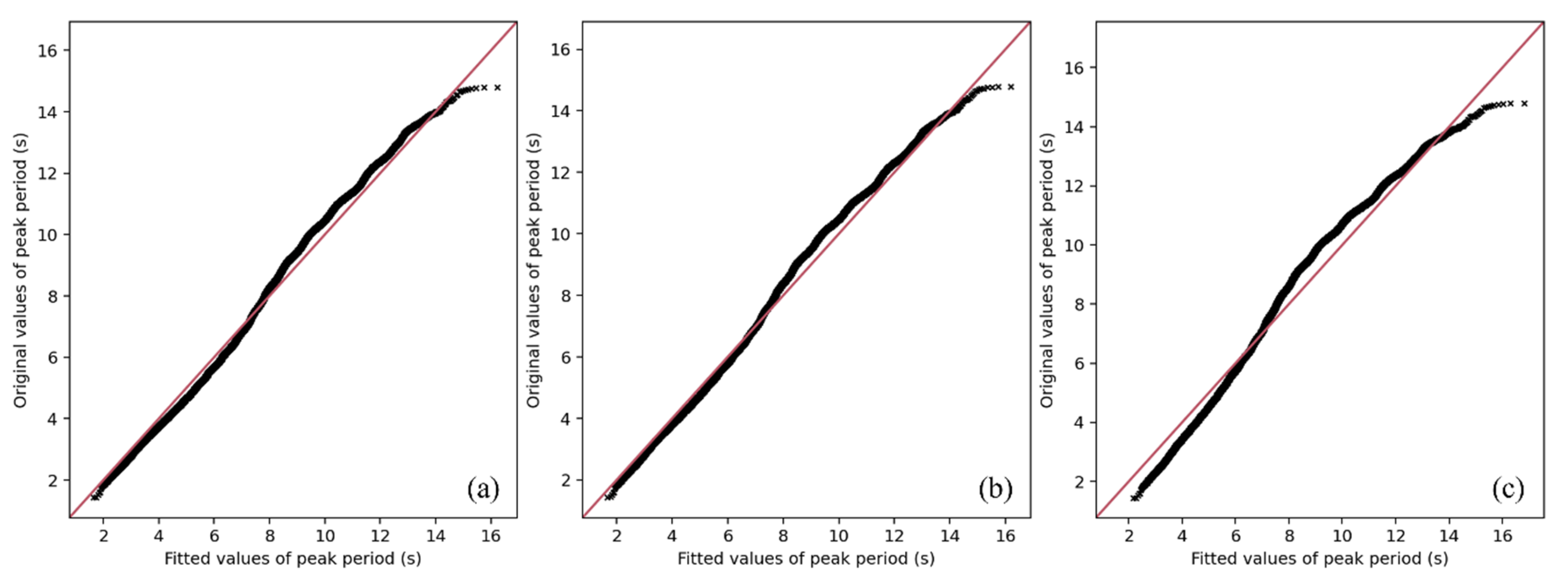


| Parametric Scheme | Dependence Function |
|---|---|
| -power3 | |
| -exp3 | |
| -insquare2 | |
| -asymdecrease3 | |
| -logistics4 | |
| -alpha3 |
| Return Period (Year) | Power3/Exp3 | Insquare2/Asymdecrease3 | Logistics4/Alpha3 | |||
|---|---|---|---|---|---|---|
| Hs (m) | Tp (s) | Hs (m) | Tp (s) | Hs (m) | Tp (s) | |
| 1 | 7.9 | 12.8 | 7.9 | 10.4 | 7.9 | 12.9 |
| 5 | 9.1 | 13.3 | 9.1 | 10.5 | 9.1 | 13.5 |
| 10 | 9.8 | 13.6 | 9.8 | 10.5 | 9.8 | 13.8 |
| 25 | 10.4 | 13.9 | 10.4 | 10.6 | 10.4 | 14.1 |
| 50 | 11.2 | 14.2 | 11.2 | 10.6 | 11.2 | 14.4 |
| 100 | 12.1 | 14.6 | 12.1 | 10.6 | 12.1 | 14.8 |
| Return Period (Year) | Power3/Exp3 | Insquare2/Asymdecrease3 | Logistics4/Alpha3 | |||
|---|---|---|---|---|---|---|
| Hs (m) | Tp (s) | Hs (m) | Tp (s) | Hs (m) | Tp (s) | |
| 1 | 7.9 | 13.2 | 7.9 | 13.3 | 7.9 | 13.4 |
| 5 | 9.1 | 13.9 | 9.1 | 14.1 | 9.1 | 14.2 |
| 10 | 9.8 | 14.4 | 9.8 | 14.5 | 9.8 | 14.6 |
| 25 | 10.4 | 14.8 | 10.4 | 14.9 | 10.4 | 15.1 |
| 50 | 11.2 | 15.3 | 11.2 | 15.4 | 11.2 | 15.6 |
| 100 | 12.1 | 15.8 | 12.1 | 15.9 | 12.1 | 16.1 |
Disclaimer/Publisher’s Note: The statements, opinions and data contained in all publications are solely those of the individual author(s) and contributor(s) and not of MDPI and/or the editor(s). MDPI and/or the editor(s) disclaim responsibility for any injury to people or property resulting from any ideas, methods, instructions or products referred to in the content. |
© 2025 by the authors. Licensee MDPI, Basel, Switzerland. This article is an open access article distributed under the terms and conditions of the Creative Commons Attribution (CC BY) license (https://creativecommons.org/licenses/by/4.0/).
Share and Cite
Liu, G.; Ouyang, Q.; He, Z.; Zhang, N. The Application of a Joint Distribution of Significant Wave Heights and Peak Wave Periods in the Northwestern South China Sea. J. Mar. Sci. Eng. 2025, 13, 570. https://doi.org/10.3390/jmse13030570
Liu G, Ouyang Q, He Z, Zhang N. The Application of a Joint Distribution of Significant Wave Heights and Peak Wave Periods in the Northwestern South China Sea. Journal of Marine Science and Engineering. 2025; 13(3):570. https://doi.org/10.3390/jmse13030570
Chicago/Turabian StyleLiu, Gongpeng, Qunan Ouyang, Zhanyuan He, and Na Zhang. 2025. "The Application of a Joint Distribution of Significant Wave Heights and Peak Wave Periods in the Northwestern South China Sea" Journal of Marine Science and Engineering 13, no. 3: 570. https://doi.org/10.3390/jmse13030570
APA StyleLiu, G., Ouyang, Q., He, Z., & Zhang, N. (2025). The Application of a Joint Distribution of Significant Wave Heights and Peak Wave Periods in the Northwestern South China Sea. Journal of Marine Science and Engineering, 13(3), 570. https://doi.org/10.3390/jmse13030570





